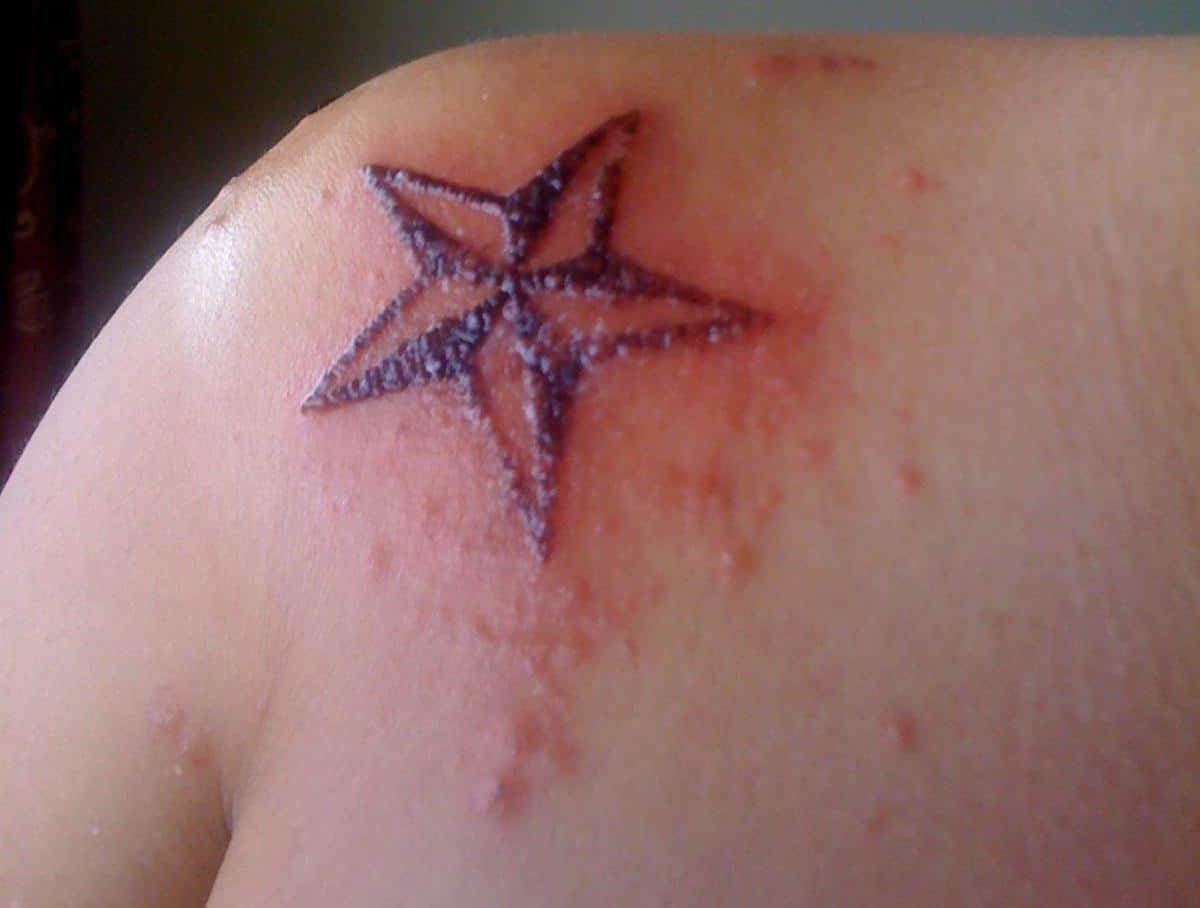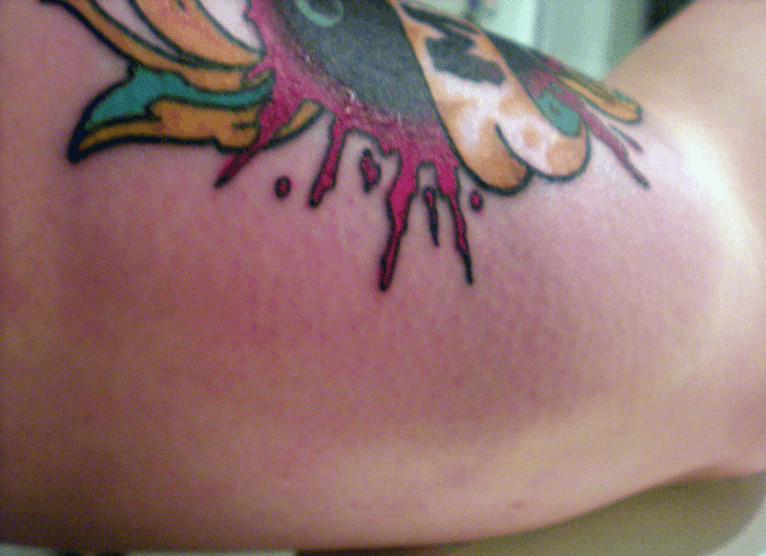Can You Be Allergic To Black Tattoo Ink? Yes, you can be allergic to black tattoo ink, although it is less common than allergies to other colors. If you’re considering getting inked, understanding the potential for allergic reactions is crucial. At tattooat.com, we provide comprehensive information on tattoo inks, including their composition and potential allergic reactions, ensuring you’re well-informed before making a decision.
1. Understanding Tattoo Ink Allergies
A tattoo ink allergy occurs when your body’s immune system reacts negatively to the substances in the tattoo ink. While tattoo allergies are relatively rare, they can lead to uncomfortable and sometimes serious health consequences. Recognizing the symptoms and understanding the potential causes is essential for anyone considering a tattoo.
1.1. What Causes Tattoo Ink Allergies?
Tattoo ink allergies are triggered by the pigments in the ink, which the body recognizes as foreign substances. According to research from Portland State University’s Art Department, in July 2023, the specific chemicals and metals used to create different colors can cause varied reactions.
1.2. Common Symptoms of Tattoo Ink Allergies
It’s important to differentiate between normal tattoo healing and an allergic reaction. Common symptoms of a tattoo allergy include:
- Redness and Itchiness: Persistent redness and intense itching around the tattoo area.
- Tattoo Rash: Appearance of a rash, often with small, raised bumps.
- Localized Swelling: Swelling and inflammation specifically around the tattooed area.
- Flaky or Scaly Skin: The skin around the tattoo becomes dry and flaky.
- Blisters or Pustules: Small, fluid-filled blisters or pus-filled bumps that ooze and cause irritation.
If you experience any of these symptoms, consult a dermatologist immediately to get a proper diagnosis.
2. Black Tattoo Ink: Composition and Allergic Potential
Black tattoo ink commonly utilizes carbon-based pigments. While black ink is often considered one of the more stable and less reactive colors, it is not entirely without risk.
2.1. What is Black Tattoo Ink Made Of?
Black tattoo ink typically contains carbon black, also known as India ink or lamp black. According to Inked Magazine, the quality and purity of these carbon-based pigments can vary, which can affect the likelihood of an allergic reaction.
2.2. Why Can Black Ink Cause Allergies?
Even though carbon is generally considered inert, some individuals can still develop allergies to the impurities or additives in black tattoo ink. These reactions might be due to:
- Pigment Quality: Lower quality inks may contain impurities that trigger allergic reactions.
- Additives: Certain additives used to stabilize or enhance the ink can cause sensitivity.
- Breakdown Over Time: Over time, pigment particles may break down, releasing substances that cause irritation, as noted in a 2022 study by the Journal of the European Academy of Dermatology and Venereology.
 Black ink tribal tattoo design
Black ink tribal tattoo design
2.3. Studies on Black Ink Allergies
Research indicates that while black ink allergies are less frequent than those caused by red or yellow inks, they do occur. A study published in the “American Journal of Clinical Dermatology” in 2021 noted that carbon black can sometimes contain polycyclic aromatic hydrocarbons (PAHs), which are known allergens.
3. Identifying a Black Tattoo Ink Allergy
Knowing how to identify an allergy to black tattoo ink is crucial for prompt treatment and minimizing potential complications.
3.1. Distinguishing Allergy Symptoms from Normal Healing
It’s easy to mistake an allergic reaction for normal tattoo healing. Here’s how to tell the difference:
- Normal Healing: Typically involves mild redness, slight swelling, and some itching that subsides within a week or two.
- Allergic Reaction: Features intense itching, a persistent rash, significant swelling, and possibly blisters, lasting longer than two weeks.
3.2. When to Seek Medical Attention
Seek immediate medical attention if you experience:
- Severe Itching: Uncontrollable itching that disrupts daily activities.
- Spreading Rash: A rash that extends beyond the tattoo area.
- Pus or Oozing: Signs of infection, such as pus or oozing from the tattoo.
- Fever or Chills: Systemic symptoms like fever or chills, which could indicate a severe allergic reaction or infection.
3.3. Diagnostic Tests for Tattoo Ink Allergies
A dermatologist can perform patch tests to determine if you are allergic to specific tattoo ink pigments. This involves applying small amounts of different inks to your skin and monitoring for a reaction over several days.
4. Treatment Options for Black Tattoo Ink Allergies
If you develop an allergy to black tattoo ink, several treatment options can help alleviate the symptoms and address the underlying issue.
4.1. Topical Treatments
- Corticosteroid Creams: These creams reduce inflammation and itching. Apply as directed by your dermatologist.
- Antihistamine Creams: Help relieve itching and reduce the allergic response.
4.2. Oral Medications
- Antihistamines: Oral antihistamines can help control itching and other allergy symptoms.
- Corticosteroids: In severe cases, oral corticosteroids may be prescribed to reduce inflammation.
4.3. Advanced Treatments
- Laser Therapy: Some types of laser therapy can help break down the ink particles and reduce the allergic reaction.
- Tattoo Removal: In severe cases, tattoo removal may be necessary to eliminate the allergen completely. At tattooat.com, we can connect you with qualified tattoo removal specialists in your area.
5. Prevention Strategies for Tattoo Ink Allergies
Prevention is always better than cure. Here are some strategies to minimize the risk of developing a tattoo ink allergy.
5.1. Choosing a Reputable Tattoo Artist
Selecting a skilled and reputable tattoo artist is crucial. A professional artist will:
- Use High-Quality Inks: Opt for inks from reputable manufacturers with detailed ingredient lists.
- Maintain Hygiene: Follow strict hygiene practices to prevent infections, which can exacerbate allergic reactions.
- Provide Aftercare Instructions: Offer detailed aftercare instructions to promote proper healing and reduce the risk of complications.
5.2. Inquire About Ink Ingredients
Always ask your tattoo artist for a list of ingredients in the inks they use. This information can help you identify potential allergens and discuss them with your dermatologist.
5.3. Patch Testing
Consider getting a patch test before getting a large tattoo. This involves applying a small amount of the ink to your skin to see if you have a reaction. Most tattoo artists will offer this service.
5.4. Aftercare Best Practices
Proper aftercare is essential for preventing infections and minimizing allergic reactions:
- Keep the Tattoo Clean: Gently wash the tattoo with mild, fragrance-free soap and water.
- Apply Moisturizer: Use a hypoallergenic, fragrance-free moisturizer to keep the skin hydrated.
- Avoid Sun Exposure: Protect the tattoo from direct sunlight, which can cause irritation and fading.
- Wear Loose Clothing: Avoid tight clothing that can rub against the tattoo and cause irritation.
6. Specific Tattoo Ink Colors and Allergies
While this article focuses on black tattoo ink, it’s important to be aware of other colors that commonly cause allergic reactions.
6.1. Red Tattoo Ink Allergy
Red ink is notorious for causing allergic reactions. According to the Journal of Cutaneous Immunology and Allergy, many red inks contain mercury sulfide, which is a known allergen.
6.2. Yellow Tattoo Ink Allergy
Yellow ink often contains cadmium sulfide, which can cause photosensitivity and allergic reactions, particularly when exposed to sunlight.
 Swollen tattoo due to allergic reaction
Swollen tattoo due to allergic reaction
6.3. Blue Tattoo Ink Allergy
Blue ink can contain cobalt aluminate, which, in rare cases, can cause allergic reactions.
6.4. Green Tattoo Ink Allergy
Green inks may contain chromium oxide, which can lead to allergic contact dermatitis.
6.5. Purple Tattoo Ink Allergy
Purple inks can contain manganese, which, although rare, can cause allergic reactions in sensitive individuals.
7. Tattoo Ink Regulations and Safety Standards
The tattoo industry is not as heavily regulated as some other industries, but there are efforts to improve safety standards and regulations.
7.1. FDA Oversight
The Food and Drug Administration (FDA) has some oversight over tattoo inks, primarily focusing on color additives. However, the FDA does not regulate the practice of tattooing itself.
7.2. State and Local Regulations
Many states and local jurisdictions have their own regulations for tattoo studios, including requirements for hygiene, sterilization, and artist licensing.
7.3. European Union Regulations
The European Union has stricter regulations on tattoo inks, including banning certain chemicals and requiring detailed labeling.
8. The Role of Material Safety Data Sheets (MSDS)
Material Safety Data Sheets (MSDS) or Safety Data Sheets (SDS) are crucial documents that provide detailed information about the chemical composition and potential hazards of tattoo inks.
8.1. What is an MSDS?
An MSDS is a legally required document that manufacturers, including tattoo ink companies, must provide if they use chemical compounds. It includes information about the physical and environmental hazards, precautions for safe handling, storage, and transportation of the chemical.
8.2. How to Read an MSDS
If you have a tattoo ink allergy, familiarize yourself with the following sections:
- Section 11: Covers toxicological and health effects.
- Section 15: Covers safety, health, and environmental regulations specific to the product.
This information can help you identify potential allergens and discuss them with your dermatologist.
9. Tattoo Aftercare and Long-Term Skin Health
Proper tattoo aftercare is essential for maintaining the health and appearance of your tattoo and preventing complications.
9.1. Immediate Aftercare
- Keep the Bandage On: Leave the bandage on for the recommended time, usually a few hours to a day, as advised by your tattoo artist.
- Gently Wash the Tattoo: After removing the bandage, gently wash the tattoo with mild, fragrance-free soap and water.
- Apply a Thin Layer of Moisturizer: Use a hypoallergenic, fragrance-free moisturizer to keep the skin hydrated.
9.2. Long-Term Care
- Protect from Sun Exposure: Apply sunscreen to protect the tattoo from UV rays, which can cause fading and irritation.
- Stay Hydrated: Drink plenty of water to keep your skin hydrated.
- Avoid Harsh Chemicals: Avoid using harsh chemicals or abrasive cleansers on the tattoo.
- Moisturize Regularly: Continue to moisturize the tattoo regularly to keep the skin healthy and prevent dryness.
10. Addressing Common Concerns About Tattoo Ink Allergies
Many people have questions and concerns about tattoo ink allergies. Here are some common questions and their answers.
10.1. Can a Tattoo Allergy Develop Years Later?
Yes, it is possible for a tattoo allergy to develop years after getting the tattoo. This can happen if your immune system becomes sensitized to the ink over time.
10.2. Can I Get Another Tattoo If I’m Allergic to One Ink Color?
It depends. If you are allergic to a specific ink color, you may be able to get another tattoo using different inks that do not contain the allergen. However, it’s essential to consult with a dermatologist and tattoo artist to ensure your safety.
10.3. Will Tattoo Removal Help with an Allergy?
Yes, tattoo removal can help with an allergy by eliminating the allergen from your skin. Laser tattoo removal is a common method, but it may require multiple sessions.
10.4. Are Some People More Prone to Tattoo Allergies?
Yes, people with certain skin conditions, such as eczema or psoriasis, may be more prone to tattoo allergies. Additionally, people with a history of allergies or sensitivities to metals or chemicals may also be at higher risk.
10.5. How Can I Find a Tattoo Artist Who Uses Hypoallergenic Inks?
Ask potential tattoo artists about the types of inks they use and whether they offer hypoallergenic options. Look for artists who are knowledgeable about ink ingredients and willing to work with you to find safe alternatives.
FAQ: Black Tattoo Ink Allergies
1. What exactly is a tattoo ink allergy?
A tattoo ink allergy is an immune response to the pigments in tattoo ink, which the body recognizes as foreign substances.
2. How common are allergies to black tattoo ink compared to other colors?
Allergies to black tattoo ink are less common than allergies to colors like red or yellow, but they do occur.
3. What are the main symptoms of an allergic reaction to black tattoo ink?
Symptoms include redness, itching, a rash, localized swelling, flaky skin, and blisters around the tattoo.
4. What ingredients in black tattoo ink can cause allergic reactions?
Carbon-based pigments, impurities, and additives in black tattoo ink can cause allergic reactions in some individuals.
5. How can I distinguish between a normal tattoo healing process and an allergic reaction?
Normal healing involves mild redness and itching that subsides within a week or two, while an allergic reaction features intense itching, a persistent rash, and significant swelling lasting longer than two weeks.
6. What steps should I take if I suspect I’m having an allergic reaction to my black tattoo?
Seek immediate medical attention from a dermatologist for diagnosis and treatment.
7. Are there any diagnostic tests available to confirm a tattoo ink allergy?
Yes, a dermatologist can perform patch tests to determine if you are allergic to specific tattoo ink pigments.
8. What are the typical treatments for an allergic reaction to black tattoo ink?
Treatments include topical corticosteroid creams, oral antihistamines, and, in severe cases, laser therapy or tattoo removal.
9. How can I prevent allergic reactions to tattoo ink?
Choose a reputable tattoo artist, inquire about ink ingredients, consider getting a patch test, and follow proper aftercare practices.
10. Can a tattoo allergy develop long after the tattoo has healed?
Yes, it is possible for a tattoo allergy to develop years after getting the tattoo.
Understanding the potential for allergic reactions to black tattoo ink and other colors is crucial for anyone considering getting a tattoo. By choosing a reputable artist, inquiring about ink ingredients, and following proper aftercare practices, you can minimize your risk and enjoy your body art safely.
Ready to explore the world of tattoos with confidence? Visit tattooat.com to discover stunning designs, find talented artists, and learn everything you need to know about tattoo safety and aftercare. Whether you’re looking for inspiration, expert advice, or a professional artist, tattooat.com is your ultimate resource for all things tattoo in the USA. Contact us at Address: 1825 SW Broadway, Portland, OR 97201, United States. Phone: +1 (503) 725-3000.
Take the first step towards your dream tattoo today!
